Transformer Cooling Methods Explained: Top 10 Powerful Techniques You Should Know
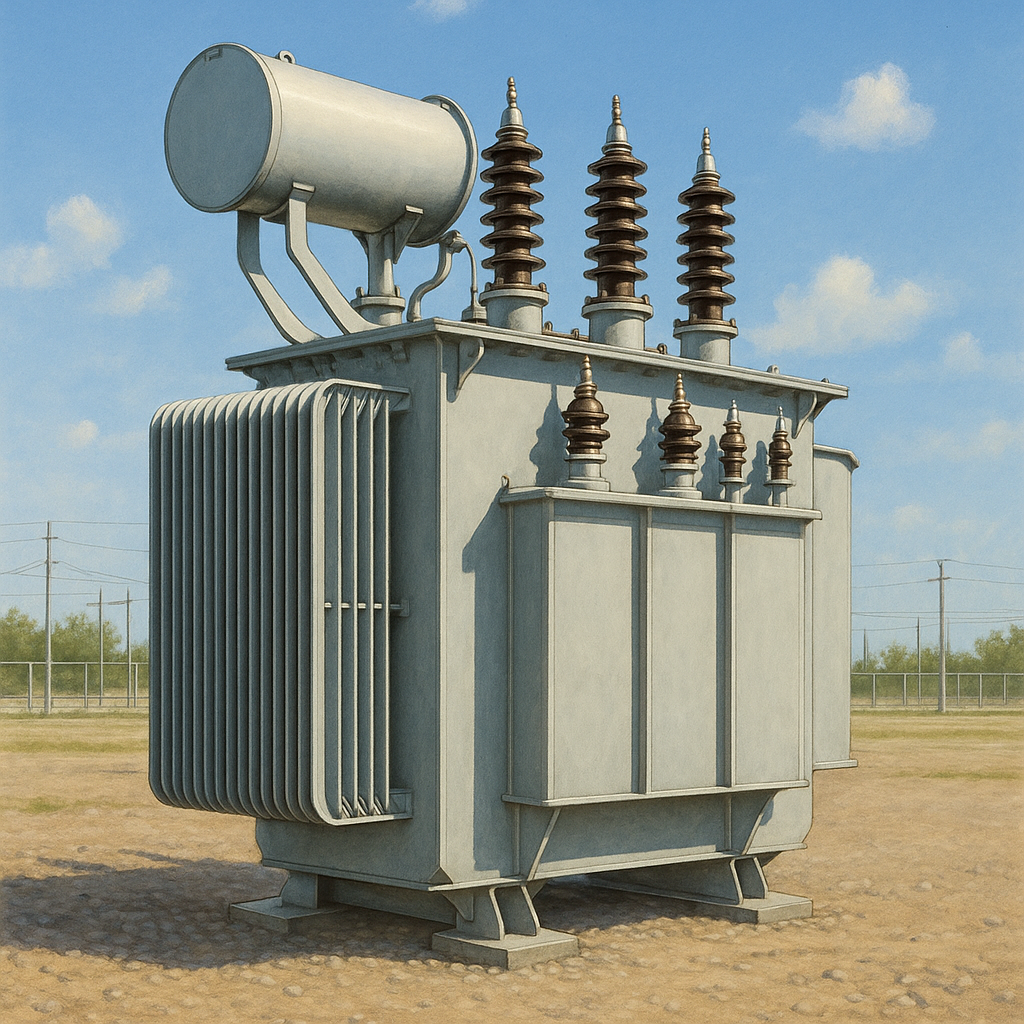
Transformers are indispensable in electrical power systems, quietly ensuring energy is transmitted safely and efficiently. Yet, what keeps them from overheating? That’s where transformer cooling methods come into play. In this detailed guide, “Transformer Cooling Methods Explained,” we explore every nuance, from natural air cooling to advanced forced oil systems, painting a comprehensive picture that both professionals and curious readers will appreciate.
Outline
Introduction to Transformer Cooling Methods Explained
Ever wondered what keeps a transformer from overheating and failing? Transformers play a vital role in transmitting electrical power, but without effective cooling, their lifespan and efficiency would plummet. Transformer cooling methods explained offers clarity on how these systems protect equipment and maintain performance.
Efficient cooling isn’t just about comfort—it’s about preventing insulation breakdown, reducing losses, and ensuring reliable energy delivery. Let’s unravel this intricate world.
What Are Transformer Cooling Methods?
Transformer cooling methods are strategies designed to control the heat generated by electrical losses. Transformers naturally heat up when operating, primarily due to copper (I²R) losses and core losses (hysteresis and eddy currents). Cooling methods manage this heat, allowing transformers to operate safely.
Whether in a power plant, factory, or hospital, cooling ensures transformers keep humming along smoothly.
Role of Heat Dissipation in Transformers
When transformers heat up, bad things can happen: insulation degrades, efficiency drops, and service life shortens. Heat dissipation keeps temperatures within safe limits, which is crucial because each 10°C rise can halve a transformer’s life.
Proper design includes cooling ducts, radiators, fans, and even pumps—each method tailored to the transformer’s rating and environment.
Natural Air Cooling (AN)
Natural Air Cooling, also known as AN or self-air cooling, relies purely on air circulation around the transformer’s surface. Simple, quiet, and maintenance-free, it’s commonly used in dry-type transformers for indoor installations with modest power demands.
While effective, it has limitations in large or high-load applications where passive airflow can’t keep up.
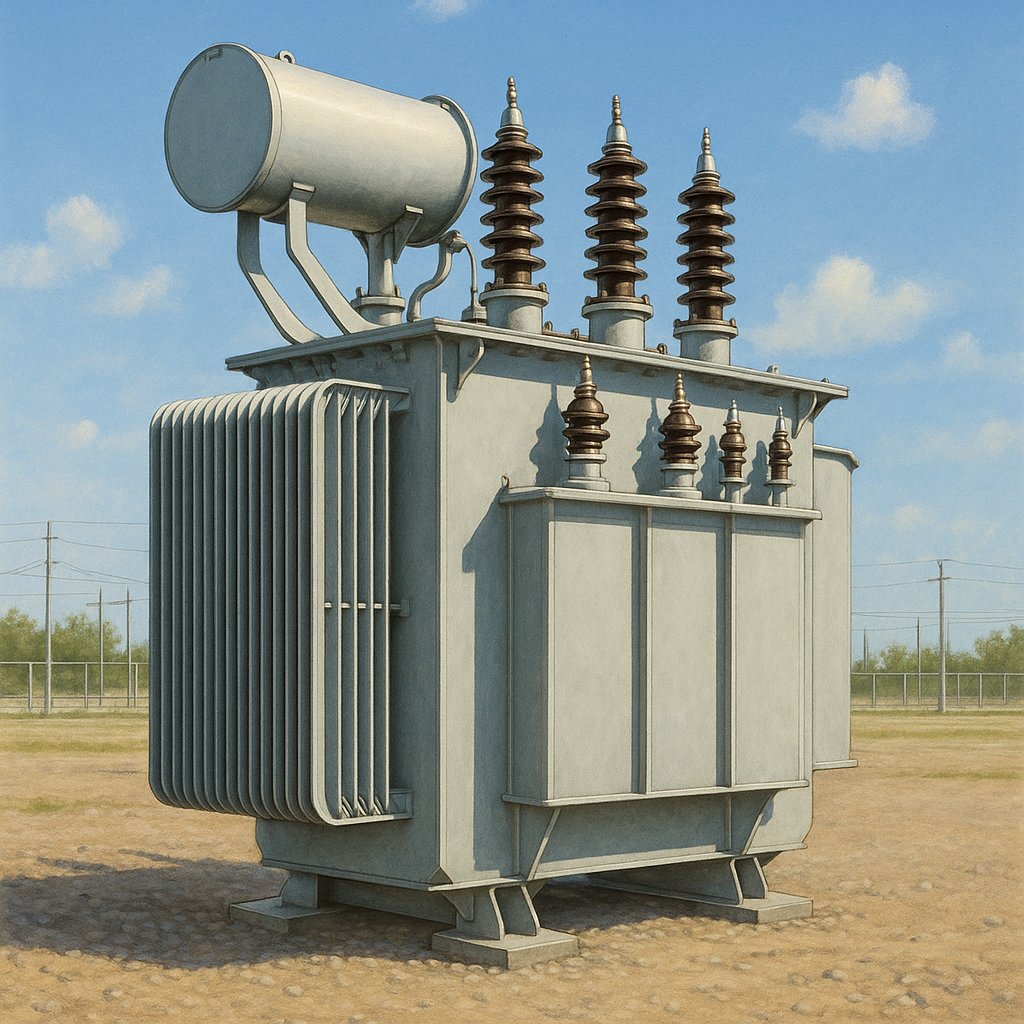
Forced Air Cooling (AF)
In Forced Air Cooling (AF), external fans push air across the transformer’s surface or windings. This method dramatically increases cooling capacity and is typically used when natural air cooling falls short.
Fans kick in automatically when sensors detect rising temperatures, offering a responsive solution for variable loads.

Natural Oil Cooling (ON)
Oil plays an exceptional role in transformer cooling. In Natural Oil Cooling (ON), heated oil rises naturally, transferring heat from windings to radiators, where it cools and sinks. This continuous cycle—called natural convection—operates without external equipment.
It’s cost-effective and reliable, especially in distribution transformers.

Forced Oil Cooling (OF)
Large power transformers often need more. Forced Oil Cooling (OF) uses pumps to actively circulate oil, speeding up heat transfer and improving efficiency. It handles higher loads and keeps temperature rise within strict limits.
While effective, it requires monitoring, power for pumps, and regular maintenance.
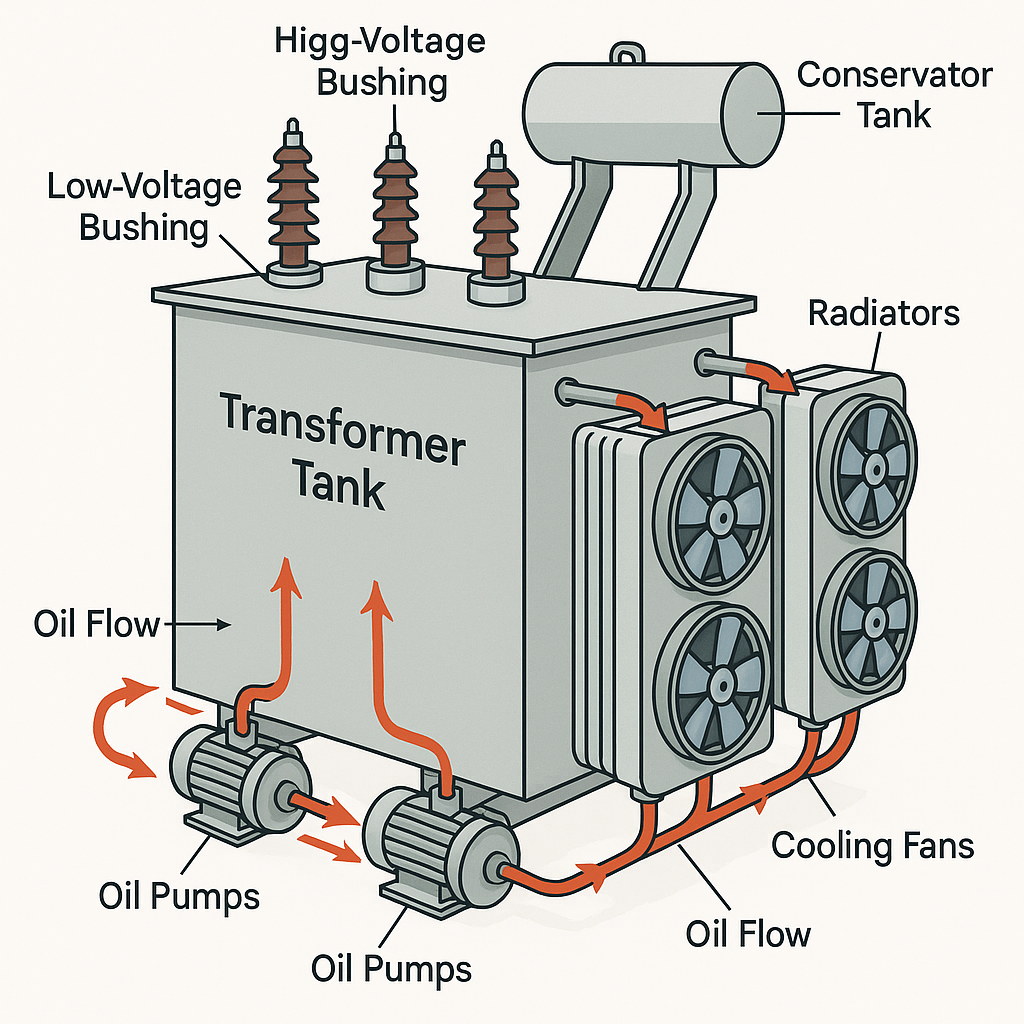
Oil Natural Air Natural (ONAN)
ONAN is the most widely used cooling method in oil-immersed transformers. Oil circulates naturally, transferring heat to radiators, and ambient air cools these radiators naturally.
Simple yet effective, ONAN works well under standard load conditions.
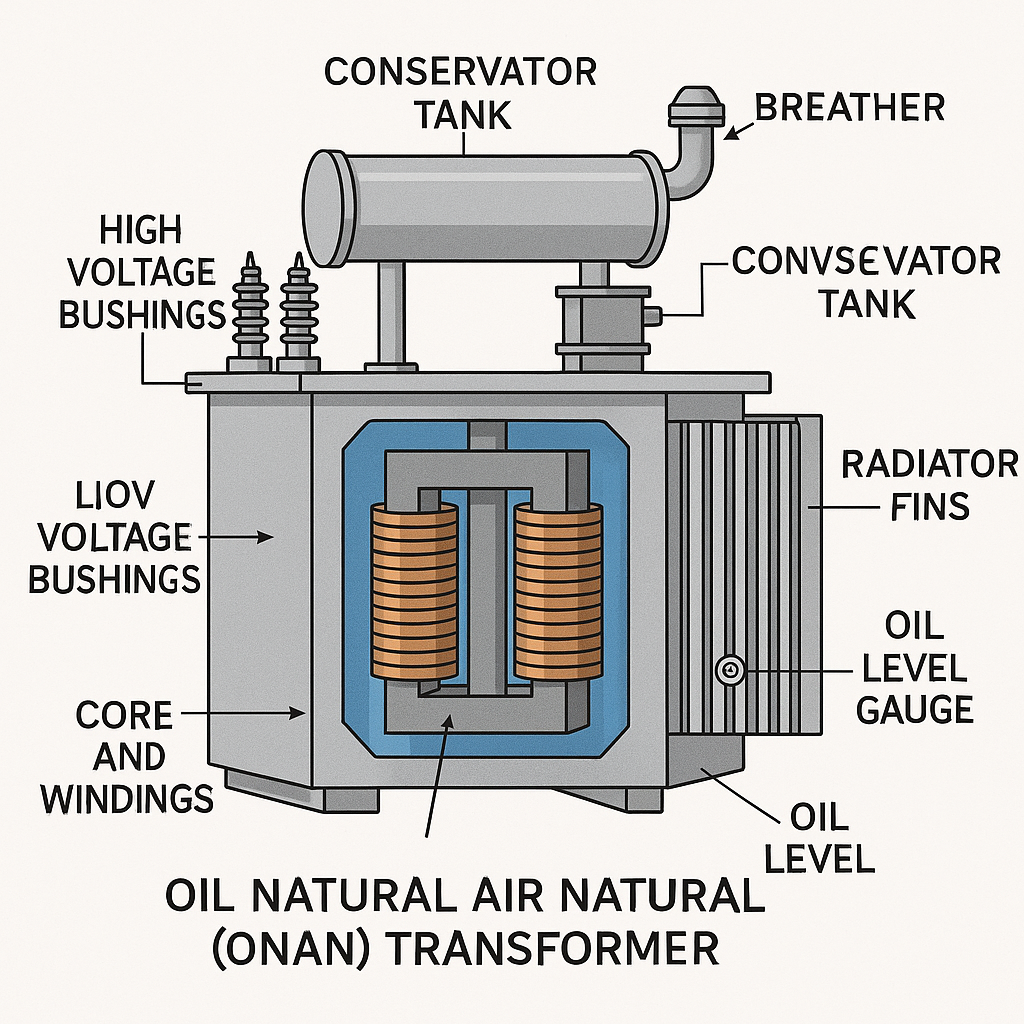
Oil Natural Air Forced (ONAF)
For peak loads, ONAN can be enhanced by adding fans, creating ONAF. The oil still circulates naturally, but fans force air over radiators, increasing cooling capacity by up to 50%.
ONAF is common in power distribution networks where load fluctuates.
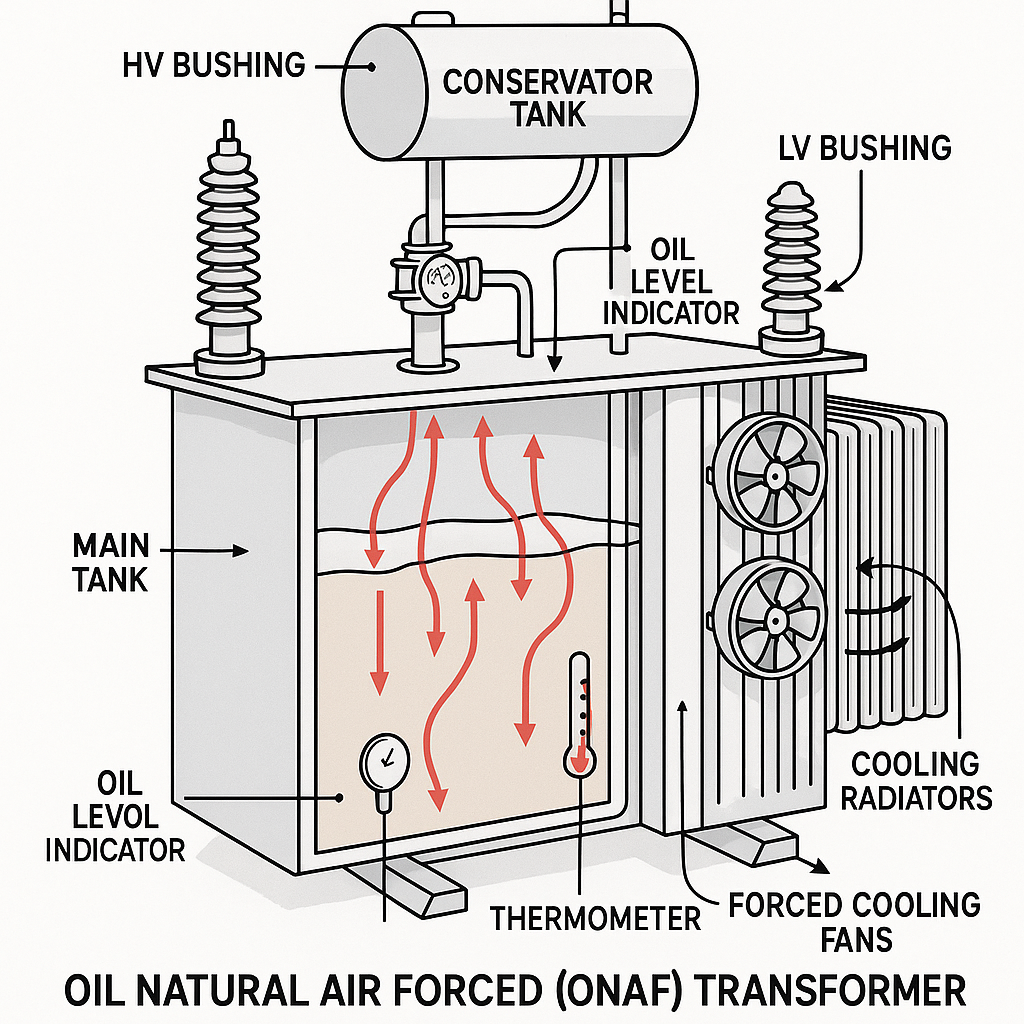
Oil Forced Air Forced (OFAF)
When loads are even higher, OFAF combines forced oil circulation with forced air cooling. Pumps move oil rapidly, and fans blow air across radiators.
This setup supports large transformers operating at higher ratings without overheating.
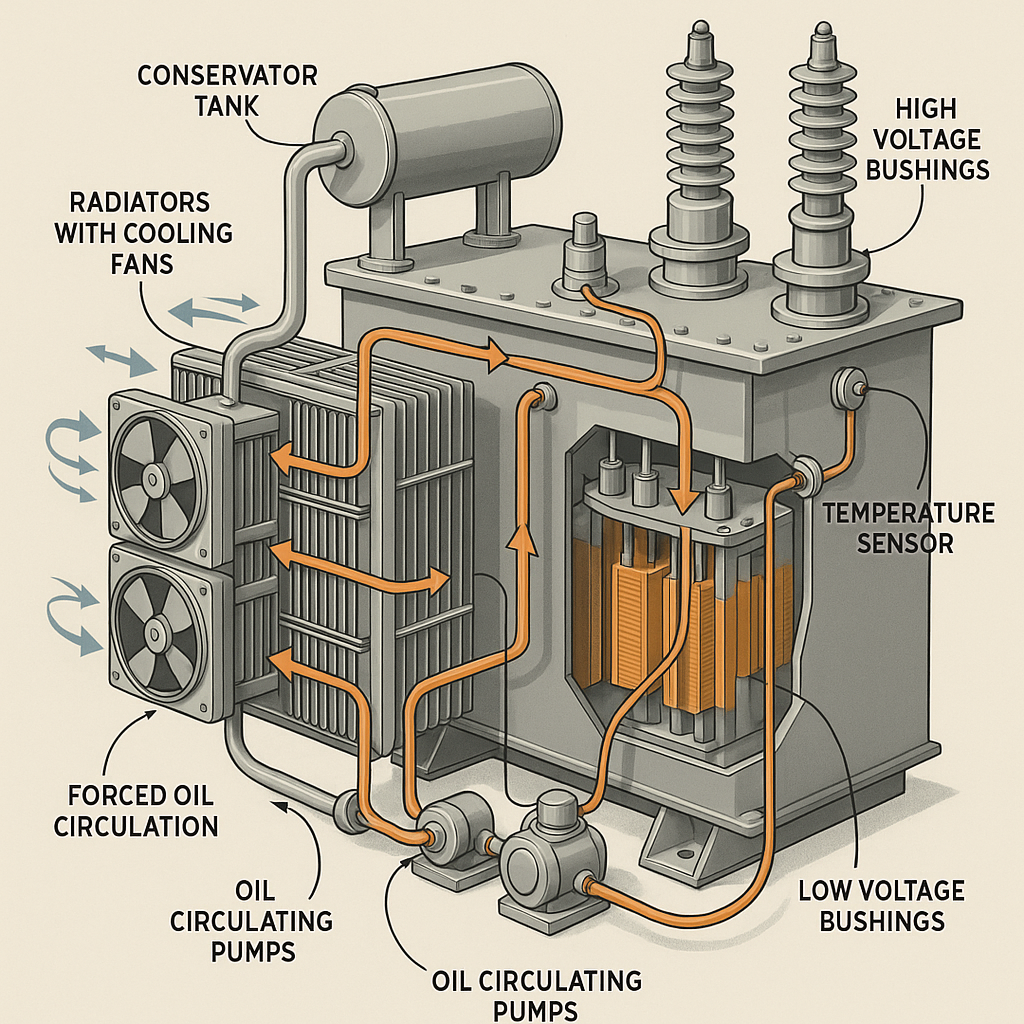
Oil Forced Water Forced (OFWF)
In huge units like generator transformers in power plants, OFWF uses forced oil circulation cooled by heat exchangers with water. This compact yet powerful method keeps temperatures stable in constrained spaces.
Its efficiency comes with complexity: water systems must be maintained to prevent leaks or contamination.
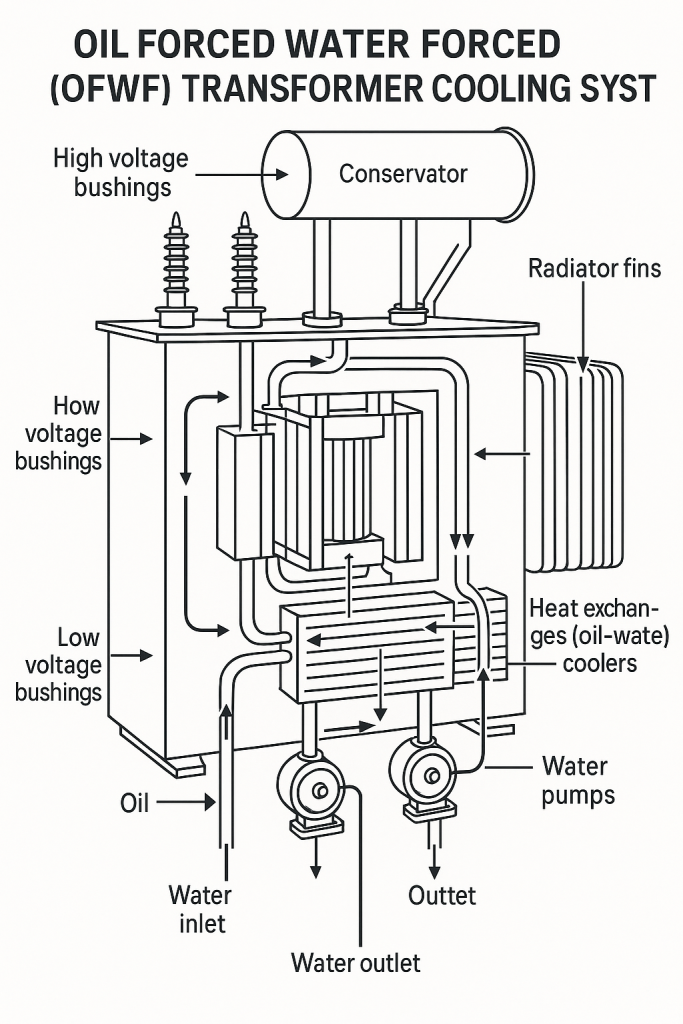
Dry Type Transformer Cooling Methods
Dry-type transformers, used indoors or where fire safety matters, don’t use oil. Their cooling methods include:
- Natural Air Cooling (AN): Relies on ambient airflow.
- Forced Air Cooling (AF): Fans enhance air movement.
They’re safer but typically larger and less efficient compared to oil-immersed transformers.
Comparison: Dry vs. Oil-Immersed Cooling
Oil-immersed cooling:
- Higher efficiency
- Smaller size
- Risk of oil leaks/fire
Dry-type cooling:
- Fire safe
- Environmentally friendly
- Larger, costlier for high ratings
The choice depends on location, load, and safety requirements.
Advantages of Oil Cooling
- Excellent heat transfer
- Compact transformer size
- Lower cost for large capacities
- Proven reliability
Oil also acts as insulation, enhancing dielectric strength.
Disadvantages of Oil Cooling
- Fire risk
- Possible environmental contamination
- Regular maintenance required
- Heavier units
Hence, alternative coolants like esters are gaining traction.
Latest Trends in Transformer Cooling
Innovations include:
- Smart temperature monitoring
- Variable speed fans and pumps
- AI-based cooling prediction
- Use of biodegradable fluids
These trends balance performance, safety, and sustainability.
Eco-friendly Cooling Fluids
Silicone oils, synthetic esters, and natural esters are transforming the industry. They offer:
- Biodegradability
- Higher flash points
- Lower toxicity
Ideal for sensitive locations like hospitals and underground substations.
Thermal Design Considerations
Thermal engineers balance:
- Conductor size
- Cooling ducts
- Radiator area
- Fan/pump power
Advanced software models heat distribution, improving reliability.
Temperature Monitoring Systems
Modern transformers use:
- RTDs (Resistance Temperature Detectors)
- Infrared sensors
- Smart relays
These systems trigger alarms or activate cooling equipment, reducing failure risks.
Failures Due to Improper Cooling
Real-world cases include:
- Insulation breakdown
- Oil degradation
- Catastrophic explosions
Most could have been avoided with better design or maintenance.
Maintenance Tips for Cooling Systems
- Clean radiators regularly
- Check oil levels and quality
- Test fans and pumps
- Inspect water circuits (OFWF systems)
Routine checks keep transformers safe and efficient.
Transformer Cooling in Harsh Environments
Special coatings, sealed radiators, and redundant cooling systems help transformers operate reliably in deserts, marine environments, or extreme cold.
Future Innovations in Cooling Methods
Expect:
- AI-driven predictive cooling
- Eco-friendly nanofluids
- Compact heat exchangers
All pushing the boundaries of transformer design.
Transformer Cooling Standards
Globally recognized norms:
- IEC 60076
- ANSI C57
- IEEE standards
These define testing, performance, and safety criteria.
FAQs about Transformer Cooling Methods Explained
Why is cooling important in transformers?
It prevents overheating, which can degrade insulation and reduce lifespan.
What is ONAN cooling?
Oil Natural Air Natural: oil circulates naturally, air cools radiators naturally.
Are dry-type transformers safer?
Yes, they pose less fire risk, making them ideal for indoor use.
What are eco-friendly cooling fluids?
Biodegradable esters and silicone oils that reduce environmental impact.
How often should cooling systems be maintained?
At least annually; more frequently for critical transformers.
What’s the newest cooling innovation?
AI-based systems that adjust cooling dynamically based on load.
Choosing the Right Cooling Method
The right cooling method balances performance, cost, space, and safety. From simple ONAN systems to advanced AI-managed OFWF setups, each method keeps transformers reliable. As power demand grows, smarter, greener cooling will shape the future of energy.
- Guide to Transformer Maintenance
- How to calculate Transformer Efficiency
- Dry-Type Transformer Applications
- Transformer Failure Case Studies
- IEEE Standards
- IEC Standards
- Transformer Cooling Guide by ABB
